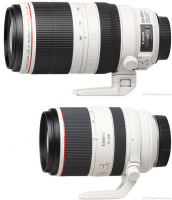The 100-400mm II has been heavily discounted again, which may be a sign that something is up. I have certainly got my money's worth from both of mine.
Upvote
0
Then it won't be a safari drive lens (unless you are carrying two white lenses on two bodies with you).
The reported size (similar to f/2.8 70-200) makes sense, as the current EF 70-200mm f/2.8 is quite similar in size to the EF 100-400mm v.2 lens.

No, this is a great way to satisfy a "photographer's dream"
100mm end of 100-400 is a bit too long at time for sports.
70-400 is your 100-400 with a wider end. Just perfect.
That's exciting! Though I wonder if they would have to make some optical compromises in order to get the size down. I thought I'd heard the 100-400 as it currently is, is one of Canon's toughest-to-make lenses, so I feel like miniaturizing that must come with a compromise or two...
landscape photographers could end up with a fine three-lens kit where four used to be required — for example, something along the lines of RF 15-35mm f/4*, 24-70mm f/4*, and this new 70-400mm lens.
The benchmark for a longer zoom is now the 200-600mm f/6.3 a la Sony, it's a cracking lens with IQ and AF way ahead of the Nikon 200-500mm f/5.6. However, both those lenses are too heavy for me, and the Sony too big. 70-400mm is the best compromise for a lightweight lens for hiking and safari. I am finding that attached to something as pixel dense as the 90D the 100-400mm II is providing a good long effective focal length as well as versatility. I, personally, want Canon to produce a really lightweight 500mm f/5.6 DO prime to rival the Nikon, as well as a 300mm DO.The state of affairs:
Customer: I would like to shoot up to 400mm with a new Canon lens that does not require crop or teleconverters to get there.Canon: Of course! Here are six lens options, starting at $1,199. All of them are pretty terrific -- you really can't go wrong.Customer: You know what? I actually need 401mm.Canon: Ooh. That's bad news for you. We at Canon believe that crossing The 401mm Barrier requires $8,999 solutions.Customer: WHAT?! Nikon has a 200-500 f/5.6 for under $1,400!Canon: [Nervous laughter] I'mmmmmm pretty sure that's not a thing. [Ninja smoke bomb, exit stage left]
I'm happy for current EF White Unicorn users with this news, but:
One might argue that the RF -600mm option is in greater need than an RF 70-400 as RF folks can adapt their various -400mm lenses already.
- EF needs a 200-500 f/5.6 IS offering
- RF people should be able to get up to 600mm with no EF f/5.6 requirement
- A
Totally agree. My Canon 100-400 II is one of my most heavily used lenses, and at least 90% of all my shots are taken at 400mm. More reach is preferable.Been beaten pretty soundly above, but I will voice my desire for more reach at the far end in exchange for the expanded width at the short end. I am good with the speed and size of the lens, but as I use the 100-400 today I find I am in need for more reach way more often then I am in need of more width.
Extremely tasty Canon and good focal range, punter can move from say 24-70 f2.8 lens and then bolt on the 70-400 lens for telephoto work.
The benchmark for a longer zoom is now the 200-600mm f/6.3 a la Sony, it's a cracking lens with IQ and AF way ahead of the Nikon 200-500mm f/5.6. However, both those lenses are too heavy for me, and the Sony too big. 70-400mm is the best compromise for a lightweight lens for hiking and safari. I am finding that attached to something as pixel dense as the 90D the 100-400mm II is providing a good long effective focal length as well as versatility. I, personally, want Canon to produce a really lightweight 500mm f/5.6 DO prime to rival the Nikon, as well as a 300mm DO.
That's exciting! Though I wonder if they would have to make some optical compromises in order to get the size down. I thought I'd heard the 100-400 as it currently is, is one of Canon's toughest-to-make lenses, so I feel like miniaturizing that must come with a compromise or two...
But I could definitely see that in my bag should I jump on board with the R system any time soon.
